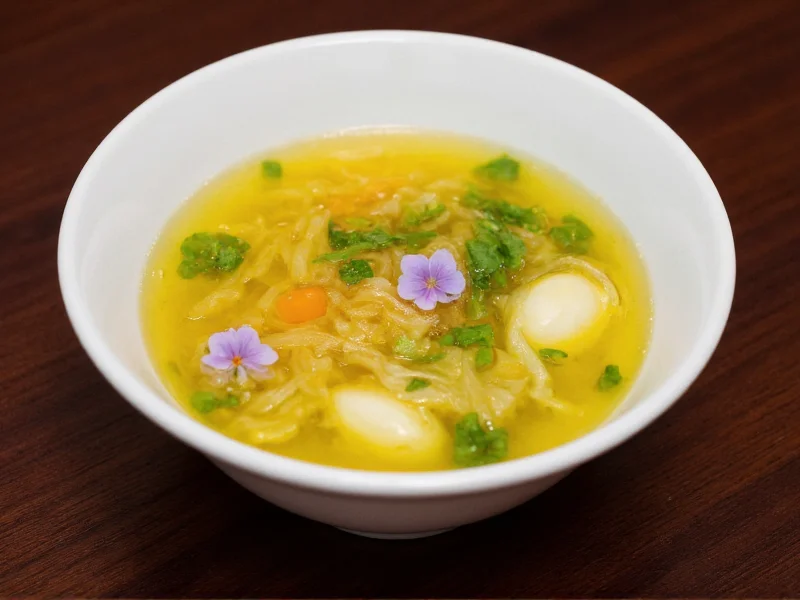The Cultural Roots of This Beloved Dish
Originating in northern China during the Han Dynasty, egg flower soup (known as \"dan hua tang\" in Mandarin) evolved as a practical solution for stretching limited ingredients. Chinese households discovered that whisking eggs into simmering broth created an elegant presentation from humble components. Unlike Western interpretations often called \"egg drop soup,\" authentic versions maintain a delicate balance of flavors without heavy starches or excessive seasonings. The soup's simplicity reflects traditional Chinese culinary philosophy where technique transforms basic ingredients into nourishing meals.
Essential Ingredients and Their Purpose
True Chinese egg flower soup requires only five core components, each serving a specific purpose in creating the perfect texture and flavor profile:
| Ingredient | Function | Authentic Substitutes |
|---|---|---|
| Homemade chicken broth | Provides rich umami base | Vegetable broth (for vegetarian version) |
| Fresh eggs | Creates signature \"flowers\" | Duck eggs (for richer texture) |
| Light soy sauce | Enhances depth without overpowering | Thin mushroom seasoning liquid |
| White pepper | Adds subtle warmth | Freshly ground black pepper |
| Cornstarch slurry | Thickens broth to ideal consistency | Arrowroot powder mixture |
Mastering the Technique: Step-by-Step Preparation
While seemingly simple, authentic Chinese egg flower soup requires precise technique to achieve the characteristic silky ribbons of egg. The critical factor is controlling the broth temperature when adding eggs. Many Western versions become scrambled due to improper heat management.
Begin by bringing your broth to a gentle simmer (not boiling) with seasonings. Prepare a cornstarch slurry using equal parts cornstarch and cold water. Slowly whisk this into the broth until it reaches a translucent sheen. Reduce heat to maintain a barely simmering temperature (approximately 180°F/82°C).
Whisk eggs thoroughly until completely uniform, then slowly drizzle them into the broth while stirring the broth in one direction with your other hand. The circular motion creates the signature \"flower\" patterns. Properly executed, the eggs should cook instantly into delicate strands without forming chunks. This technique for making egg drop soup without lumps separates authentic preparation from common restaurant versions.
Regional Variations Across China
While the basic preparation remains consistent, regional Chinese egg flower soup variations reflect local preferences and available ingredients:
- Northern China: Features a clear broth with minimal cornstarch, emphasizing the pure egg flavor
- Southern China: Often includes dried scallops or shrimp for added umami complexity
- Sichuan version: Incorporates a hint of chili oil for subtle heat beneath the delicate egg flavor
- Cantonese style: May include finely shredded mushrooms and bamboo shoots for texture
Professional Tips for Perfect Results
Seasoned Chinese chefs emphasize several often-overlooked details when preparing traditional Chinese egg flower soup ingredients:
- Egg temperature matters: Use room-temperature eggs for smoother integration into the broth
- Whisking technique: Beat eggs in one direction only to create uniform texture
- Broth consistency: The ideal thickness should coat the back of a spoon without being gloppy
- Seasoning balance: Add salt before cornstarch to ensure even distribution
- Finishing touch: A few drops of sesame oil added after cooking enhances aroma without overwhelming
Nutritional Profile and Dietary Considerations
Authentic Chinese egg flower soup provides surprising nutritional benefits beyond its comforting qualities. A standard serving (1 cup) contains approximately 60-80 calories, with 5-7 grams of high-quality protein from the eggs. Unlike many restaurant versions loaded with sodium, homemade versions allow control over salt content while maintaining the traditional Chinese egg flower soup recipe's healthful properties.
The soup's light broth base supports hydration, while the eggs contribute essential amino acids and choline. For those following gluten-free diets, authentic preparation naturally meets these requirements when using tamari instead of traditional soy sauce. Vegetarian versions using mushroom broth maintain the dish's integrity while accommodating dietary restrictions.
Serving Traditions and Pairing Suggestions
In Chinese culinary tradition, egg flower soup serves specific purposes beyond mere taste. It's commonly served at the beginning of meals to prepare the stomach for digestion, or as a light evening meal when appetite is diminished. The soup's gentle nature makes it ideal for recovery from illness, explaining its popularity as home remedy across Chinese communities worldwide.
For authentic presentation, serve in small bowls at the start of a meal. Pair with steamed rice and simple stir-fried vegetables for a complete light meal. During winter months, many Chinese households add a small amount of fresh ginger juice to the broth for additional warming properties. This traditional Chinese egg flower soup variation demonstrates how minor adjustments serve specific health purposes within Chinese dietary philosophy.
Troubleshooting Common Preparation Issues
Even experienced cooks encounter challenges with this deceptively simple dish. Understanding these common problems ensures consistent results with your authentic Chinese egg flower soup recipe:
- Scrambled eggs instead of flowers: Broth temperature too high - reduce to gentle simmer before adding eggs
- Muddy-colored broth: Using dark soy sauce instead of light variety - always opt for thin, light soy
- Excessive starchiness: Too much cornstarch - use 1 teaspoon per cup of broth maximum
- Bland flavor: Broth lacks depth - simmer bones with ginger for at least 2 hours for homemade stock
- Eggs sinking to bottom: Not whisking broth while adding eggs - maintain constant gentle stirring











 浙公网安备
33010002000092号
浙公网安备
33010002000092号 浙B2-20120091-4
浙B2-20120091-4